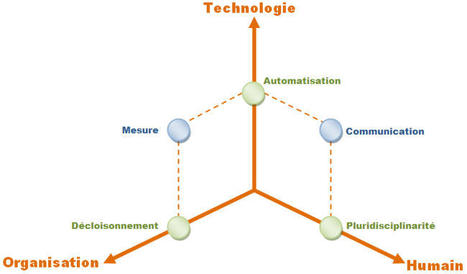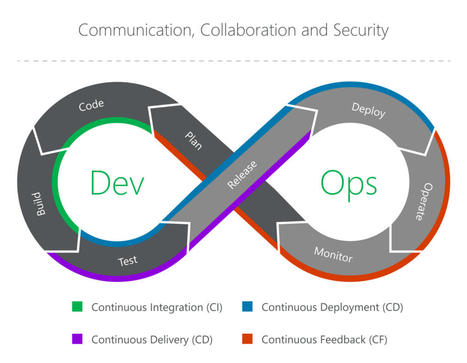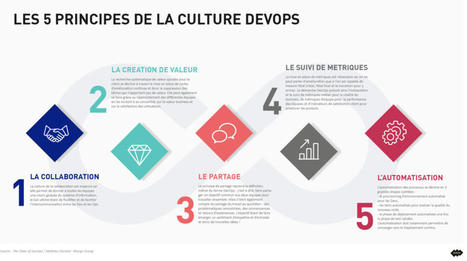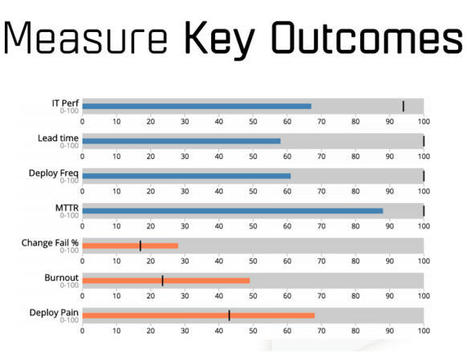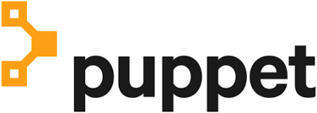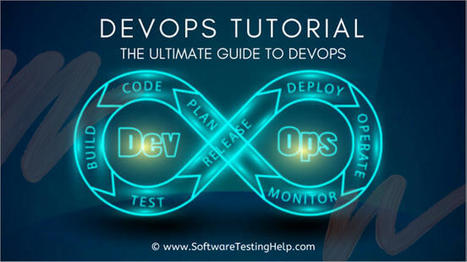Comme toutes les méthodes agiles, DevOps agit sur trois axes : l’humain, l’organisation et la technologie. Les cinq aspects de la méthode DevOps se retrouvent dans chacun de ces trois axes.
Get Started for FREE
Sign up with Facebook Sign up with X
I don't have a Facebook or a X account

 Your new post is loading... Your new post is loading...
 Your new post is loading... Your new post is loading...
Current selected tag: 'devops'. Clear
Why are so many organizations stuck in the "middle" of DevOps evolution? What's preventing them from achieving higher levels of organizational performance des…
An annual report on the state of DevOps explains how companies adapt and develop DevOps practices in their IT systems.
Let's define the software development life cycle, make an overview of the 7 most used models, and find out their differences and benefits in projec
Mickael Ruau's insight:
The DevOps model has its unique principles that promote automation and team collaboration. Therefore, the primary focus of the model is the enhancement of collaboration between teams that are driven by sequential feedback. The DevOps model resembles the Agile methodology, but differs due to the collaboration focus between technical team members and managers, while Agile focuses on client involvement. What does DevOps carry out?
Bien souvent je travaille avec des équipes, agiles ou non, dont l’attention se porte naturellement sur la fourniture de nouvelles fonctionnalités. Or, dans cette course à la production de valeur pour rester compétitif face à la concurrence, les équipes doivent faire un choix. Elles se retrouvent régulièrement dans cette situation compliquée où il faut faire…
Tom's Obvious, Minimal Language. Contribute to toml-lang/toml development by creating an account on GitHub.
Mickael Ruau's insight:
TOML shares traits with other file formats used for application configuration and data serialization, such as YAML and JSON. TOML and JSON both are simple and use ubiquitous data types, making them easy to code for or parse with machines. TOML and YAML both emphasize human readability features, like comments that make it easier to understand the purpose of a given line. TOML differs in combining these, allowing comments (unlike JSON) but preserving simplicity (unlike YAML). Because TOML is explicitly intended as a configuration file format, parsing it is easy, but it is not intended for serializing arbitrary data structures. TOML always has a hash table at the top level of the file, which can easily have data nested inside its keys, but it doesn't permit top-level arrays or floats, so it cannot directly serialize some data. There is also no standard identifying the start or end of a TOML file, which can complicate sending it through a stream. These details must be negotiated on the application layer. INI files are frequently compared to TOML for their similarities in syntax and use as configuration files. However, there is no standardized format for INI and they do not gracefully handle more than one or two levels of nesting. Further reading:
Get InvolvedDocumentation, bug reports, pull requests, and all other contributions are welcome! WikiWe have an Official TOML Wiki that catalogs the following:
At Teleport we do IT a little differently — supporting a global remote company in hypergrowth is no easy feat and the playbook is different from traditional IT work. In this article, we want to share some of our IT philosophies that enable our employees to keep their agility despite working very asynchronously around the world.
In my last article, I covered the basics of DevOps and highlighted the benefits that have motivated so many organisations to shift for this new model for software development. This article will build…
Mickael Ruau's insight:
It’s Continuous Feedback that ties the ends of the loop together, feeding back data and analytics from the Operate and Monitor phases back into the Plan phase to do it all over again.
Mickael Ruau's insight:
A number of things, really, but let me focus on two here, and a third with the next definition.
De nombreuses interactions sur Internet compliquent inutilement les concepts DevOps. Il faut veiller à ce que cette approche reste simple, sans quoi la confiance des équipes risque d’en pâtir au point d’en ralentir l’évolution.
Le DevOps en pratique
L’ANSSI est l'autorité nationale en matière de sécurité et de défense des systèmes d’information. Prévention, protection, réaction, formation et labellisation de solutions et de services pour la sécurité numérique de la Nation.
Il existe une confusion entre DevOps, SRE (Site Reliability Engineer), SysAdmin et Ingénieur Cloud. Nous éclaircissons ces métiers dans cet article. |
Learning organizations smoothly morph as they adapt to new challenges—and they unlearn existing ways of working when those become limitations.
Mickael Ruau's insight:
We are regularly asked if we know any DevOps or site reliability engineering (SRE) experts available for hire. Our answer is, invariably, "Not really." It's a tough market out there. DevOps and SRE (for large-scale software, at least) are critical approaches for success in modern software delivery and operations, as widely demonstrated every year in the State of DevOps report or the array of presentations at the DevOps Enterprise Summit. But if you think you can achieve DevOps by hiring "DevOps experts," you are missing some contextual awareness. What exactly are you trying to improve in the first place?
If your software delivery is slow because of work you're handing off among multiple teams with diverse schedules and priorities, will a new hire really help?
We're not suggesting that you not hire people with diverse skills and backgrounds—that can be quite valuable to bring in new perspectives and approaches. But conventional hiring based on expertise alone is ineffective and prevents organizations from developing the "learning muscles" that can help teams traverse the latest trends (DevOps, SRE, etc.) to their benefit at the right time, and in the right context.
Hiring experts for every need is like engaging in palliative care for organizational health. Preventive care would be to incorporate the necessary team structures and interactions—as well as a focus on people growth and sufficient slack—to effectively take in process, technology, and business changes.
Learning organizations smoothly morph as they adapt to new challenges, and they unlearn existing ways of working when they become limitations rather than enablers.
This article explains the DevOps process and principles. It gives you insights to implement the DevOps methodology in your software development process.
Mickael Ruau's insight:
Implementing DevOps in your teamIf your team has not yet implemented a DevOps process or even an Agile one, it can seem confusing, especially because it means shift not only the organization but also the culture of your team. To introduce DevOps in your team you have to take your time, go step by step, don’t rush it. Here is how to gradually implement this new culture and organization:
Keep in mind that adding those processes will change your organization and create new needs. For instance, your team may require training for the new DevOps tools that have been implemented.
You will reach the true DevOps environment when your development process will be as automated and agile as possible.
Culture eats strategy for breakfast, and DevOps, too, needs strong culture to thrive. Here's how to implement and sustain a DevOps culture.
Mickael Ruau's insight:
In his article, “7 Key Principles for a Successful DevOps Culture,” Kaya Ismail identified seven principles that can form a framework for determining your DevOps culture goals. 1. Foster a Collaborative Environment – Break down silos to bring people, processes and tools towards a unified focus on the customer.
Nombre de nos clients ont engagé ou envisagent une transformation DevOps. Comme nous l’avons vu dans notre article précédent (DevOps en 2017: les vrais enjeux et bénéfices), le DevOps est un véritable enjeu de transformation pour la compétitivité des entreprises : réduction du time to market, amélioration de la qualité de service, prise en compte du feedback…
DevOps Guide - Development to Production all configurations with basic notes to debug efficiently. - GitHub - Tikam02/DevOps-Guide: DevOps Guide - Development to Production all configurations with basic notes to debug efficiently.
Mickael Ruau's insight:
Getting Started DevOps Links:
Continuous improvement is the basis of the DevOps methodology. It is always a challenge in which engineers must identify potential time losses.
Using Software Intelligence to understand where and why DevOps goes awry.
Mickael Ruau's insight:
Applying Software Intelligence to each stage can provide the transparency and data that makes each stage timely and efficient.
C'est la culture, et non la technologie, qui fait obstacle au succès de DevOps, selon un rapport de Puppet, spécialiste de l'automatisation des infrastructures Alors que 83 % des décideurs informatique
Katharina Probst discusses some of the best practices to build, evolve, and operate microservices, learnings from containers, service meshes, DevOps, Chaos & load testing, and planning for growth.
A deep dive on how we crafted an order of magnitude change in our spend (10x reduction compared to baseline growth) over the last two years with iterative understanding and changes in Slack’s Continuous Integration (CI) infrastructure.
What You Will Learn: [hide] |



